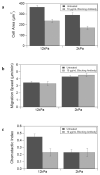Neutrophil adhesion and chemotaxis depend on substrate mechanics
- PMID: 20473350
- PMCID: PMC2867619
- DOI: 10.1088/0953-8984/22/19/194117
Neutrophil adhesion and chemotaxis depend on substrate mechanics
Abstract
Neutrophil adhesion to the vasculature and chemotaxis within tissues play critical roles in the inflammatory response to injury and pathogens. Unregulated neutrophil activity has been implicated in the progression of numerous chronic and acute diseases such as rheumatoid arthritis, asthma, and sepsis. Cell migration of anchorage-dependent cells is known to depend on both chemical and mechanical interactions. Although neutrophil responses to chemical cues have been well characterized, little is known about the effect of underlying tissue mechanics on neutrophil adhesion and migration. To address this question, we quantified neutrophil migration and traction stresses on compliant hydrogel substrates with varying elasticity in a micro-machined gradient chamber in which we could apply either a uniform concentration or a precise gradient of the bacterial chemoattractant fMLP. Neutrophils spread more extensively on substrates of greater stiffness. In addition, increasing the stiffness of the substrate leads to a significant increase in the chemotactic index for each fMLP gradient tested. As the substrate becomes stiffer, neutrophils generate higher traction forces without significant changes in cell speed. These forces are often displayed in pairs and focused in the uropod. Increases in the mean fMLP concentration beyond the K(D) of the receptor lead to a decrease in chemotactic index on all surfaces. Blocking with an antibody against beta(2)-integrins leads to a significant reduction but not an elimination of directed motility on stiff materials, but no change in motility on soft materials, suggesting neutrophils can display both integrin-dependent and integrin-independent motility. These findings are critical for understanding how neutrophil migration may change in different mechanical environments in vivo and can be used to guide the design of migration inhibitors that more efficiently target inflammation.
Figures









Similar articles
-
Traction forces exerted by epithelial cell sheets.J Phys Condens Matter. 2010 May 19;22(19):194119. doi: 10.1088/0953-8984/22/19/194119. Epub 2010 Apr 26. J Phys Condens Matter. 2010. PMID: 21386442
-
Interplay between shear stress and adhesion on neutrophil locomotion.Biophys J. 2007 Jan 15;92(2):632-40. doi: 10.1529/biophysj.105.079418. Epub 2006 Oct 27. Biophys J. 2007. PMID: 17071667 Free PMC article.
-
Traction forces of neutrophils migrating on compliant substrates.Biophys J. 2011 Aug 3;101(3):575-84. doi: 10.1016/j.bpj.2011.05.040. Biophys J. 2011. PMID: 21806925 Free PMC article.
-
Leukocyte adhesion dynamics in shear flow.Ann Biomed Eng. 2002 Mar;30(3):315-32. doi: 10.1114/1.1467677. Ann Biomed Eng. 2002. PMID: 12051617 Review.
-
Signaling in the motility responses of the human neutrophil.Ann Biomed Eng. 2002 Mar;30(3):356-70. doi: 10.1114/1.1477446. Ann Biomed Eng. 2002. PMID: 12051620 Review.
Cited by
-
Neuromechanobiology: An Expanding Field Driven by the Force of Greater Focus.Adv Healthc Mater. 2021 Oct;10(19):e2100102. doi: 10.1002/adhm.202100102. Epub 2021 Aug 2. Adv Healthc Mater. 2021. PMID: 34342167 Free PMC article. Review.
-
Biomechanics of Cardiac Function.Compr Physiol. 2015 Sep 20;5(4):1623-44. doi: 10.1002/cphy.c140070. Compr Physiol. 2015. PMID: 26426462 Free PMC article. Review.
-
Biomimetic, ultrathin and elastic hydrogels regulate human neutrophil extravasation across endothelial-pericyte bilayers.PLoS One. 2017 Feb 24;12(2):e0171386. doi: 10.1371/journal.pone.0171386. eCollection 2017. PLoS One. 2017. PMID: 28234918 Free PMC article.
-
Macrophage motility is driven by frontal-towing with a force magnitude dependent on substrate stiffness.Integr Biol (Camb). 2015 Apr;7(4):447-53. doi: 10.1039/c4ib00260a. Integr Biol (Camb). 2015. PMID: 25768202 Free PMC article.
-
Collagen concentration regulates neutrophil extravasation and migration in response to infection in an endothelium dependent manner.Front Immunol. 2024 Jul 3;15:1405364. doi: 10.3389/fimmu.2024.1405364. eCollection 2024. Front Immunol. 2024. PMID: 39021568 Free PMC article.
References
-
- BALABAN NQ, SCHWARZ US, RIVELINE D, GOICHBERG P, TZUR G, SABANAY I, MAHALU D, SAFRAN S, BERSHADSKY A, ADDADI L, GEIGER B. Force and focal adhesion assembly: a close relationship studied using elastic micropatterned substrates. Nat Cell Biol. 2001;3:466–72. - PubMed
-
- CHOQUET D, FELSENFELD DP, SHEETZ MP. Extracellular Matrix Rigidity Causes Strengthening of Integrin-Cytoskeleton Linkages. Cell. 1997;88:39. - PubMed
-
- CHEN CE, ODDE DJ. Traction Dynamics of Filopodia on Compliant Gels. Science. 2008;322:1687–1691. - PubMed
Publication types
MeSH terms
Grants and funding
LinkOut - more resources
Full Text Sources
Other Literature Sources
Research Materials
